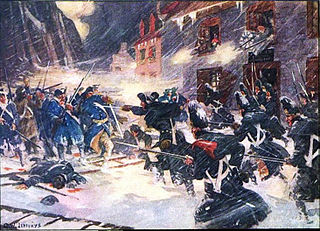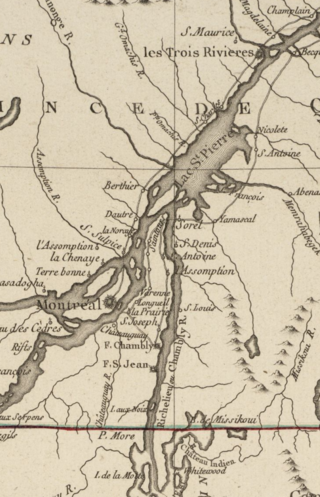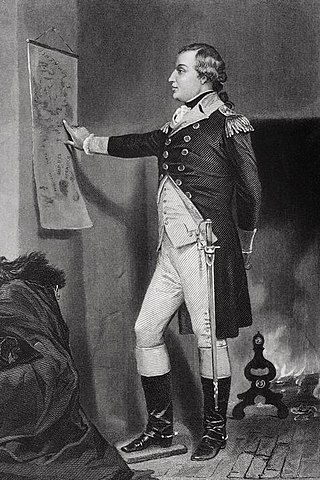This article needs additional citations for verification .(December 2022) |
Sir Charles Preston, 5th Baronet (c. 1735 - 23 March 1800) was a British Major who was stationed in Canada during the American Revolutionary War.
This article needs additional citations for verification .(December 2022) |
Sir Charles Preston, 5th Baronet (c. 1735 - 23 March 1800) was a British Major who was stationed in Canada during the American Revolutionary War.
He was ordered by Gen. Guy Carleton to delay the American advance on Montreal, and Quebec. He was in command of 662 men of the 26th Regiment, engineers, Canadians, and Indians. [1] They held Fort Saint-Jean, at Saint-Jean-sur-Richelieu, Quebec, in 1775 when it came under siege by American General Richard Montgomery, and resisted multiple attacks by troops under command of Montgomery and Philip Schuyler. [2] His troops held the fort in hopes of being rescued by reinforcements for two months before surrendering [3] on the third of November 1775. [4] [5]
On his return to Valleyfield, Fife, in 1784, he became Member of Parliament for Dysart, from 1774 to 1790. [6] After his death, the Preston baronetcy passed to his brother, Robert.

Preston is mentioned in a Fort Saint-Jean plaque erected in 1926 by Historic Sites and Monuments Board of Canada at the Royal Military College Saint-Jean. "Constructed in 1743 by M. de Léry under orders from Governor la Galissonnière. This post was for all the military expeditions towards Lake Champlain. On 31 August 1760, Commandant de Roquemaure had it blown up in accordance with orders from the Governor de Vaudreuil in order to prevent its falling into the hands of the English. Rebuilt by Governor Carleton, in 1773. During the same year, under the command of Major Charles Preston of the 26th Regiment, it withstood a 45-day siege by the American troops commanded by General Montgomery.:

Guy Carleton, 1st Baron Dorchester, known between 1776 and 1786 as Sir Guy Carleton, was a British Army officer, peer and colonial administrator. He twice served as Governor of the Province of Quebec, from 1768 to 1778, concurrently serving as Governor General of British North America in that time, and again from 1785 to 1795. The title Baron Dorchester was created on 21 August 1786.

The Invasion of Quebec was the first major military initiative by the newly formed Continental Army during the American Revolutionary War. The objective of the campaign was to seize the Province of Quebec from Great Britain, and persuade French-speaking Canadiens to join the revolution on the side of the Thirteen Colonies. One expedition left Fort Ticonderoga under Richard Montgomery, besieged and captured Fort Saint-Jean, and very nearly captured British General Guy Carleton when taking Montreal. The other expedition, under Benedict Arnold, left Cambridge, Massachusetts, and traveled with great difficulty through the wilderness of Maine to Quebec City. The two forces joined there, but they were defeated at the Battle of Quebec in December 1775.

The Battle of Quebec was fought on December 31, 1775, between American Continental Army forces and the British defenders of Quebec City early in the American Revolutionary War. The battle was the first major defeat of the war for the Americans, and it came with heavy losses. General Richard Montgomery was killed, Benedict Arnold was wounded, and Daniel Morgan and more than 400 men were taken prisoner. The city's garrison, a motley assortment of regular troops and militia led by Quebec's provincial governor, General Guy Carleton, suffered a small number of casualties.
The capture of Fort Ticonderoga occurred during the American Revolutionary War on May 10, 1775, when a small force of Green Mountain Boys led by Ethan Allen and Colonel Benedict Arnold surprised and captured the fort's small British garrison. The cannons and other armaments at Fort Ticonderoga were later transported to Boston by Colonel Henry Knox in the noble train of artillery and used to fortify Dorchester Heights and break the standoff at the siege of Boston.

This section of the timeline of Quebec history concerns the events between the fall of Quebec as part of New France during the French and Indian Wars and as part of British North America, through the adoption of the Quebec Act (1774), until just before the division of the province into Upper and Lower Canada by the Constitutional Act (1791).

Events from the year 1775 in Canada.

Philippe de Rigaud, Marquis de Vaudreuil was a French military officer who served as Governor General of New France from 1703 to 1725, throughout Queen Anne's War and Father Rale's War.

The Battle of Trois-Rivières was fought on June 8, 1776, during the American Revolutionary War. A British army under Quebec Governor Guy Carleton defeated an attempt by units from the Continental Army under the command of Brigadier General William Thompson to stop a British advance up the Saint Lawrence River valley. The battle occurred as a part of the American colonists' invasion of Quebec, which had begun in September 1775 with the goal of removing the province from British rule.

The Battle of Longue-Pointe was an attempt by Ethan Allen and a small force of American and Quebec militia to capture Montreal from British forces on September 25, 1775, early in the American Revolutionary War. Allen, who had been instructed only to raise militia forces among the local inhabitants, had long had thoughts of taking the lightly defended city. When he reached the southern shore of the St. Lawrence River with about 110 men, he seized the opportunity to try. Major John Brown, whom Allen claimed was supposed to provide additional forces, did not appear as they had planned, isolating Allen and his men on the north side of the river.

The Siege of Fort St. Jean was conducted by American Brigadier General Richard Montgomery on the town and fort of Saint-Jean, also called St. John, St. Johns, or St. John's, in the British province of Quebec during the American Revolutionary War. The siege lasted from September 17 to November 3, 1775.

The 1st Canadian Regiment (1775–1781) was an Extra Continental regiment of the American Patriots' Continental Army, consisting primarily of volunteers from the Province of Quebec. The 1st was raised by James Livingston to support Patriot efforts in the American Revolutionary War during the invasion of Quebec. Livingston, who was born in New York and living in Quebec, recruited men from Chambly, Quebec as early as September 1775, but a formal regimental designation was made by Richard Montgomery on November 20, 1775, with recognition by the Second Continental Congress following on January 8, 1776. The regiment, which never approached its authorized size of 1,000 men, saw action primarily in the Canadian theater and New York, and was disbanded on January 1, 1781, at King's Ferry, New York.

Roland-Michel Barrin de La Galissonière, Marquis de La Galissonière, sometimes spelled Galissonnière, was the French governor of New France from 1747 to 1749 and the victor in the Battle of Minorca in 1756.

The 84th Regiment of Foot (Royal Highland Emigrants) was a British regiment in the American Revolutionary War that was raised to defend present day Ontario, Quebec and Atlantic Canada from the constant land and sea attacks by American Revolutionaries. The 84th Regiment was also involved in offensive action in the Thirteen Colonies; including North Carolina, South Carolina, Georgia, Virginia and what is now Maine, as well as raids upon Lake Champlain and the Mohawk Valley. The regiment consisted of 2,000 men in twenty companies. The 84th Regiment was raised from Scottish soldiers who had served in the Seven Years' War and stayed in North America. As a result, the 84th Regiment had one of the oldest and most experienced officer corps of any regiment in North America. The Scottish Highland regiments were a key element of the British Army in the American Revolution. The 84th Regiment was clothed, armed and accoutred the same as the Black Watch, with Lieutenant Colonel Allan Maclean commanding the first battalion and Major General John Small of Strathardle commanding the second. The two Battalions operated independently of each other and saw little action together.
Moses Hazen was a brigadier general in the Continental Army during the American Revolutionary War. Born in the Province of Massachusetts Bay, he saw action in the French and Indian War with Rogers' Rangers. His service included particularly brutal raids, during the Expulsion of the Acadians and the 1759 Battle of Quebec. He was formally commissioned into the British Army, shortly before the war ended, and retired on half-pay outside Montreal, Province of Quebec, where he and Gabriel Christie, another British officer, made extensive land purchases in partnership. During his lifetime he acquired land in Quebec, New Hampshire, Vermont, and New York, but lost most of his Quebec land due to litigation with Christie and the negative effects of the Revolution.

The Battle of Saint-Pierre was a military confrontation on March 25, 1776, near the Quebec village of Saint-Pierre, south of Quebec City. This confrontation, which occurred during the Continental Army's siege of Quebec following its defeat at the Battle of Quebec, was between forces that were both largely composed of Canadian militia, including individuals on both sides of the conflict that had been recruited in the same communities. The Patriot forces routed the Loyalist forces, killing at least 3 and capturing more than 30.
The 71st Regiment of Foot was a British Army regiment of infantry raised in 1775, during the American Revolutionary War and unofficially known as Fraser's Highlanders. It was disbanded in 1786.

Fort Saint-Jean is a fort in the Canadian province of Quebec located on the Richelieu River. The fort was first built in 1666 by soldiers of the Carignan-Salières Regiment of France who had travelled to New France to assist the young colony. It was part of a series of forts built along the Richelieu River. Over the years, it was destroyed and rebuilt several times, but it is, after Quebec City, the military site that has been occupied non-stop for the longest time in Canada. The fort is designated as a National Historic Site of Canada, and it currently houses the Royal Military College Saint-Jean. The fort has been continually occupied since 1748, and is the core from which the city of Saint-Jean-sur-Richelieu, Quebec grew around. Fort Saint-Jean played a crucial role in the British defense strategy during the 1775 American invasion of the Province of Quebec.

The military career of Benedict Arnold in 1775 and 1776 covers many of the military actions that occurred in the northernmost Thirteen Colonies early in the American Revolutionary War. Arnold began the war as a captain in Connecticut's militia, a position to which he was elected in March 1775. Following the outbreak of hostilities at Lexington and Concord the following month, his company marched northeast to assist in the siege of Boston that followed. Arnold proposed to the Massachusetts Committee of Safety an action to seize Fort Ticonderoga in New York, which he knew was poorly defended. They issued a colonel's commission to him on May 3, 1775, and he immediately rode off to the west, where he arrived at Castleton in the disputed New Hampshire Grants in time to participate with Ethan Allen and his men in the capture of Fort Ticonderoga. He followed up that action with a bold raid on Fort Saint-Jean on the Richelieu River north of Lake Champlain. He then resigned his Massachusetts commission after a command dispute with the head of a detachment of Connecticut militia troops that arrived in June to reinforce Ticonderoga.

Richard Montgomery was an Irish-born American military officer who first served in the British Army. He later became a major general in the Continental Army during the American Revolutionary War, and he is most famous for leading the unsuccessful 1775 invasion of northeastern Quebec.